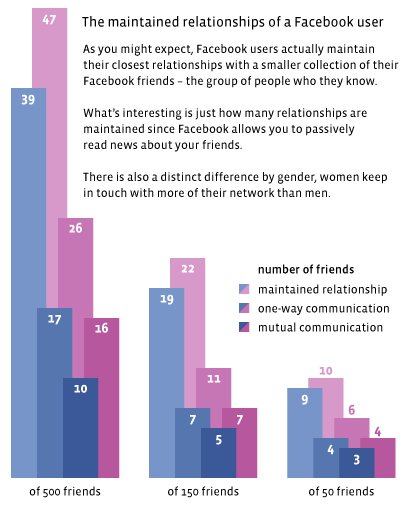Clay Shirky, who popularized the concept of cognitive surplus, the time freed from watching television which can be enormously productive, talks in an interview about the risks of social media and broadcasting yourself on the internet. Shirky provides the following example: “The employer says: ‘Anything that is accessible to me is also acceptable to me.'” While in the real world there is a notion of privacy in public spaces (e.g. listening in the neighbors’ conversation in a restaurant is considered wrong), this notion lacks in the semi-public semi-private sphere of social networks and the internet. Shirky concludes that unless we find a better solution than the existing one, we will “have robbed young people of something that they won’t even know they are missing, because they never leave the web of surveillance.”
Doing Homework with a Search Engine Optimized Brain

Mother: ”Turn off the iPod.” ”Stop with the video chat!” ”NO TEXTING while you’re supposed to be doing homework!”
Son: ”MOM! Stop. I can concentrate better with music on.”
Daughter: ”I need the video chat on. I’m going over homework with my friends.”
Sounds familiar? In the above CBS News video neuroscientist Gary Small explains how technology may be making us smarter and why it may be good to let our kids become internet savvy multitaskers. Hopefully, they never forget that communication isn’t concentration, and information isn’t education. Fortunately, so far no one bars a search engine optimized brain from reading a book.
23+1 Chatrouletters. Don’t watch this video! Or watch it twice.
This Video-Performance is banned from Youtube. So please be careful! You might find the performance by artist duo Eva and Franco Mattes aka 0100101110101101.ORG offending. But if you watch it you can find out a lot about online social interaction.
“No Fun” was performed on chatroulette.com, a website that pairs random strangers for webcam-based conversations. What would you do watching a hanging man on chatroulette? Well, in the beginning you might believe what you see isn’t real. But then…
Call the police? Take a picture? Play the guitar? Or put on your sun glasses?
The performance’s set up is quite disturbing because the artists’ webcam captures the observer when the latter is looking at a suicide. The spatial structure and positioning of the screen and camera reminds of Diego Velázquez’ Las Meninas. As in Velásquez’ painting “No Fun” creates a deeply uncertain relationship between the viewer and the viewed. In fact, the one who is watching is being watched. Don’t watch this video! Or watch it twice.

(thank you @MrsBunz and 0100101110101101.ORG)
Socialnomics – Nice Video, crude Statistics

Erik Qualman says: “Statistics Show Social Media Is Bigger Than You Think”.
I would say: “Social Media Shows How Flexible Statistics Have Become!”
- Over 50% of the world’s population is under 30-years-old – That is right.
- 96% of Millennials have joined a social network – In this context, it is wrong! The truth is slightly different: Trendspotting found in a surveys on the US young generation that 96% of online teens/tweens report ever having used any type of social networking technology including IM/chat, text messaging and email.
- Facebook tops Google for weekly traffic in the U.S. – That is right. https://www.hitwise.com/us/datacenter/main/dashboard-10133.html
- Social Media has overtaken porn as the #1 activity on the Web – That is right since 2009. https://latimesblogs.latimes.com/technology/2009/01/social-media-po.html
- 1 out of 8 couples married in the U.S. last year met via social media – I could not find the cited McKinsey study. Everyone on the web cites McKinsey but no one links to the source.
- Years to Reach 50 millions Users: Radio (38 Years), TV (13 Years), Internet (4 Years), iPod (3 Years)… – I could not verify these numbers but the authors cite https://cyberschoolbus.un.org/
- Facebook added over 200 million users in less than a year – That may be right, but only in the 6th year of facebook’s existence. If really compared to Radio, TV, Internet and iPod (point 6), it would be right to say: facebook (4 Years). Facebook reached 1 Million in 2004, 5.5 Million in 2005, 12 Million in 2006, 50 Million in 2007, 100 Million in 2008 and 350 Million in 2009. https://www.facebook.com/press/info.php?timeline
- iPhone applications hit 1 billion in 9 months. – 1 Billion what? Apples? However, one billion Downloads from the Appstore, to be honest. What is social about downloading an app for iPhone and iPod touch? https://www.apple.com/itunes/billion-app-countdown/
- “We don’t have a choice on whether we DO social media, the question is how well we DO it.” – Another question is how well we DO statistics.
- If Facebook were a country it would be the world’s 3rd largest ahead of the United States and only behind China and India – That might be true, but obviously facebook isn’t a country. Would you compare your TV to a country? Or your Mobile Phone? Otherwise you could say: Mobile Phones are the world’s biggest country. https://en.wikipedia.org/wiki/List_of_countries_by_number_of_mobile_phones_in_use Read more
The School of Facebook

“The children now love luxury; they have bad manners, contempt for authority; they contradict their parents, chatter before company, gobble up dainties at the table, cross their legs, and tyrannize their teachers.” This famous misquotation of ancient Greek philosopher Socrates became popular in the 1960s, when it was used by the Mayor of Amsterdam and reported by The New York Times, on April 3, 1966.

Nowadays, parents and teachers once again are concerned about the bad manners or the social well-being of their kids.
Americans between the ages of 8 and 18 spend on average of 7 hours and 38 minutes a day using some sort of electronic device, from smartphones to MP3 players to computers, The Kayser Family Foundation reported earlier this year. You can go to any campus or school, and you will probably find an immediate flipping up of phones and texting when the lesson is over. Parents are concerned about the fact that kids no longer care about language as an art and gift. And they wonder: If some of these digital natives have more than 500 “friends” on social networks like Facebook, do we have to be concerned about the future?
We do, certainly. But we should look a little bit closer first. As The Economist reported in an article entitled “Primates on Facebook” last year, even people with very many Facebook friends, mutually communicate only with some happy few. 10 to 16 people, according to a study of the Facebook Data Team, taking into account gender differences. The average user on Facebook has “only” 120 confirmed friend connections and mutually communicates with 3 to 7 people. This looks quite similar to the good old concept of friendship.

And even if Facebook seems to devaluate the term “friend”, and although parents might be impressed or scared of the social multitasking skills of their children, digital natives seem to be able to build up and maintain friendships in their social networks. As the Economist put it: “The neocortex is the limit.”
It was Robin Dunbar, an anthropologist from Oxford, who extrapolated from the brain sizes and social networks of apes and suggested that the size of the human brain allows stable networks of about 148. Many institutions, from neolithic villages to the maniples of the Roman army, seem to be organized around this Dunbar number. And even digital natives in their new habitat of social networks do not exceed those limits.
Until recently concerns about the use of technology have been focused on the implications for kids’ intellectual development. Now, it is taken into account how technology is affecting social relationships and friendship. This brings the worry about the social repercussions of technology from the darker side of online interactions, like cyber-bullying or texting sexually explicit messages, to the light.
In my opinion, most of the concerns of the elder generation result from something Remo Largo, swiss MD and early childhood specialist would call “misfit” between Kids’ behavior and their environment. Then education would be about rearranging learning and living to better match the children’s individual needs. That means new approaches to digital literacy to address a second digital divide. But it is also about being interested in the kids’ needs and their new virtual habitat. Better education will help them to find the balance between broadcasting and privacy, networking and friendship, multitasking and concentration, lightweight conversation and personal reflection, online networks, and real life.
This southpark episode is a very good starting point: